Post by Tom Pemberton
Planning the Tour of Flanders ride.
Back in the summer, after watching the cobbles stage of the Tour de France. As a fan of watching the cobbled races – I wanted to get in on the action. My initial thought was to do Paris- Roubaix. After suggesting it in the group chat, Dickie suggested the Tour of Flanders sportive. After a bit of research, I decided that this was the better option. Jim and Dickie’s mate Dave signed up as well.
For those that are not aware, the Tour of Flanders is a one-day race in the Flanders region of Belgium. It is one of the five ‘monument races’ in the calendar year and one that all pro’s want to win. The race is the culmination of several weeks of racing in the region. The route was known for its short but steep roads that were constructed from cobbles rather than tarmac. Some of the hills are famous through-out the cycling world. Cyclists travel from all round the world to suffer them.
As part of the weekend, there is an amateur sportive to let you try a similar route. The Tour of Flanders sportive is the day before the pro race with four distances, 74km, 144km, 177km and 242km. With around 15,000 riders signed up across the different routes. We all signed up for the 177km as this took in most of the climbs. The 242km (the most like the pro race) started and finished in different towns, causing some logistical issues. It also mainly consisted of a lot of flat roads before the fun started.
With all the Cyclocross I’d been doing, this should be a doodle, right?
Preparing for the Tour of Flanders
So on the Friday before the Tour of Flanders, the four of us left in two cars down to Folkestone. We got the channel tunnel across to France, where there where several other cars full of bikes and riders. After getting to France, we drove onto Oudenaarde in Belgium, the town where the race is all based.
The journey was under 2 hours so not a long time to get to the ride. After getting our registration packs from the event centre we went to our hotel in the City of Ghent. I found Oudenaarde to be quite small. We noted that a lot of the hotels had been booked out very early by the teams, media and travel companies. Ghent was less the 30 minutes away so was a good option as many others were doing the same.
Pasta time with discussion of the weather
After checking into the hotel, we had dinner at a local pasta restaurant. We consumed the largest bowls of pasta ever. We could not even finish the meal. A strict one Duvel per person limit was in place. Our conversation mainly around the weather forecast, and the summary of 60% rain. We discussed in detail what the weather forecast meant for us in the upcoming ride. The next morning was an early start with a 6:30 meet, as we had an approximate start time between 7am-8am. Once we reached the outskirts of Oudenaarde, we followed directions by marshals and police to the local commercial car park.

The weather was very cold with a bit of rain in the air; rain jackets, full length leg warmers and overshoes were all put on before we headed to the start. For those interested in bike setups – I used my normal road bike. Though I put on 28mm wide tyres with pressures of 60 and 65 psi, with inner tubes. Dickie and Dave also went with their road bikes, though were tubeless. Jim went for his gravel bike which had 40mm+ wide tyres, also tubeless. Jim decided to drop down to the 144km course, which was a very easy process and then we started, with a rolling start.
The Tour of Flanders ride
The route went out along the river, then once over the bridge along the other side before starting to head out of town. The first berg, Wolvenberg, came at only 9Km into the ride as was tarmac hill, only 600mm long with a max gradient of 11%. This was a nice little warm up for the legs. The next two cobbled sections we rode were considered flat on the route.
Trying to describe the feeling of riding over them is very difficult. Even holding onto the tops of the handlebars very lightly, you feel the vibrations in all parts of your body. Your heart rate also goes through the roof as you have to put in a big effort to keep momentum on the cobbles.
I’ve never been so happy to be riding on smooth tarmac. I will never complain about the state ok the UK roads again. The first cobbled climb came at 22Km, the Molenberg. This is only 500m long, with a max gradient of 10.5%. this was successfully navigated and gave me confidence that I can climb these, the only bad thing was that according to Dickie’s Garmin, it was one of the 19 climbs on the course.
Leaving the cobbles behind, for a while
The route then followed a series of main road, farm tracks and cycle paths. It was continually changing direction, head wind then tail wind, up then down. Despite the number of riders, the roads were open to all traffic, though they were very quiet. Also, at all junctions there were marshals, and often when approaching the junction they had stopped traffic and you could just ride around the corner without having to stop.
The next climb and cobble sectors came at 44, 47 and 49Km. This was where the 144 and 177 routes split. The longer route went west on to Geraardsberg. The route was now more on larger roads, and with a tailwind it started to feel like some of the kilometres were starting to tick by.
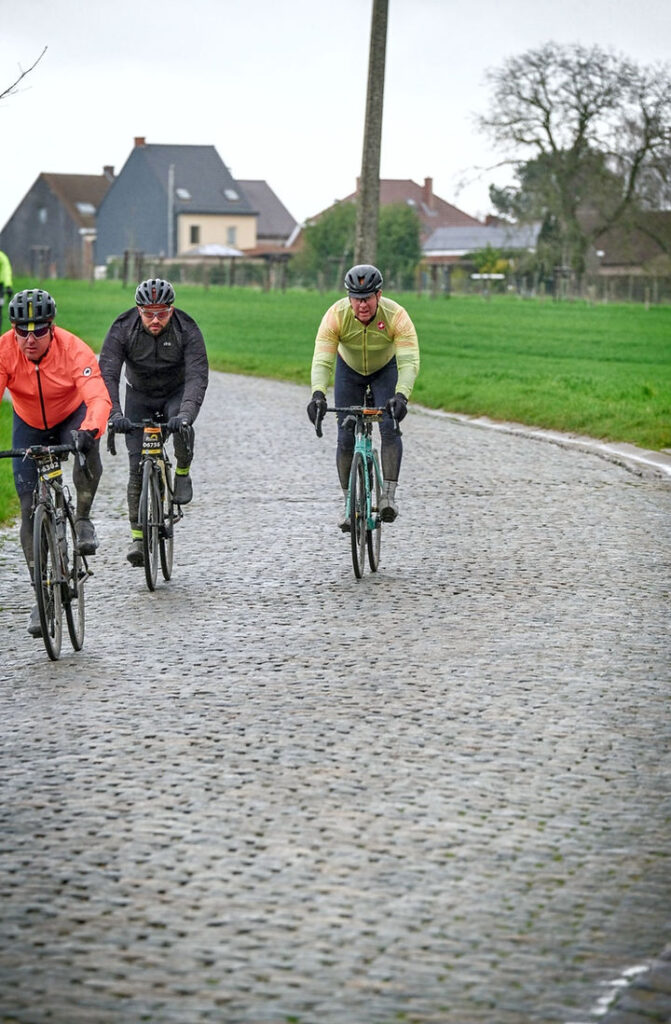
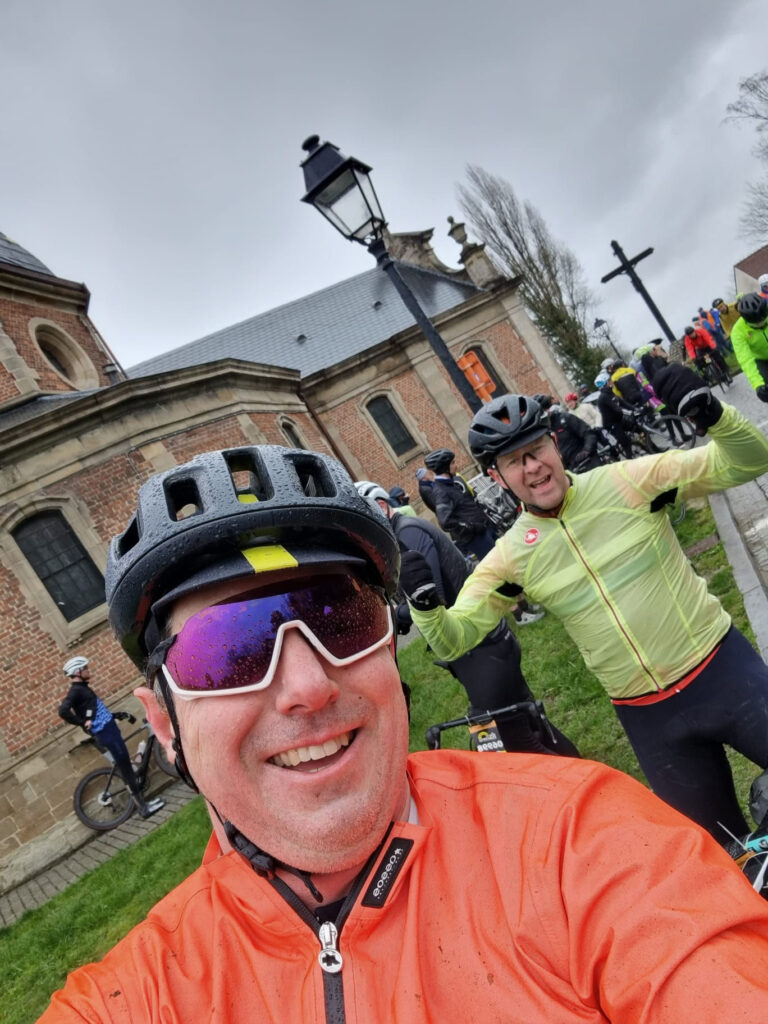
Dickie and Dave at the top of the Muur van Geraardsbergen
Muur van Geraardsbergen
The first major climb of the Tour of Flanders was the Muur van Geraardsbergen, which is the famous Flanders cobbled climb with the church at the top. The climb is over 1.0km in length with an average gradient of 9.5% and a max of 11%. It starts off in the main town on smooth newish cobbles, but as you go further up, the gradient gets steeper, and the cobbles get rougher. As I reached the steep section, there was a group of locals cheering you on which helped get you over the last part of the climb. At the top was a feed station were stopped for waffles, sandwiches and biscuits.
The descent from the top was on nice wide roads with sweeping bends, we then headed back East to Oudenaarde. This part of the route was not the most interesting as it was mainly on roads and only had two climbs in 30km. Fortunately we got into a large group which helped save some energy.
Feed stop at Oudenaarde
The 144km route joined back in at this point. At times it looked like it was going to stop raining and be dry for a bit, only for when I thought about taking off the rain jacket it started to rain again. The next feed stop was back in Oudenaarde at 112km. An opportunity for a break and coffee was taken as we were about to head into the more famous / feared climbs in Flanders. Just a couple of KMs after the feed station, we had to stop to join the queue at the base of the Koppenberg.
The organisers of the Tour of Flanders hold back riders so that the climb is not so crowded to give a chance of riding up it. For those that do not know, the Koppenberg is the most feared climb in the whole region. It is only 600m long, but has gradients above 20% on very rough cobbles, with the worst section in the middle and is also very narrow with room for only 3 riders wide.
Once we got to the front of the queue, it was a quick dash to the bottom of the climb. The road ramps up in front of you and is very intimidating. I felt I was going well whilst riders around me had to get off and start walking. However, I ran out of room with the walkers and the slippery cobbles and had to dismount myself. After walking about 50m, I manage to get back on the bike and ride to the top. Gutted that I didn’t ride it all, but the only consolation was no one else around did either.
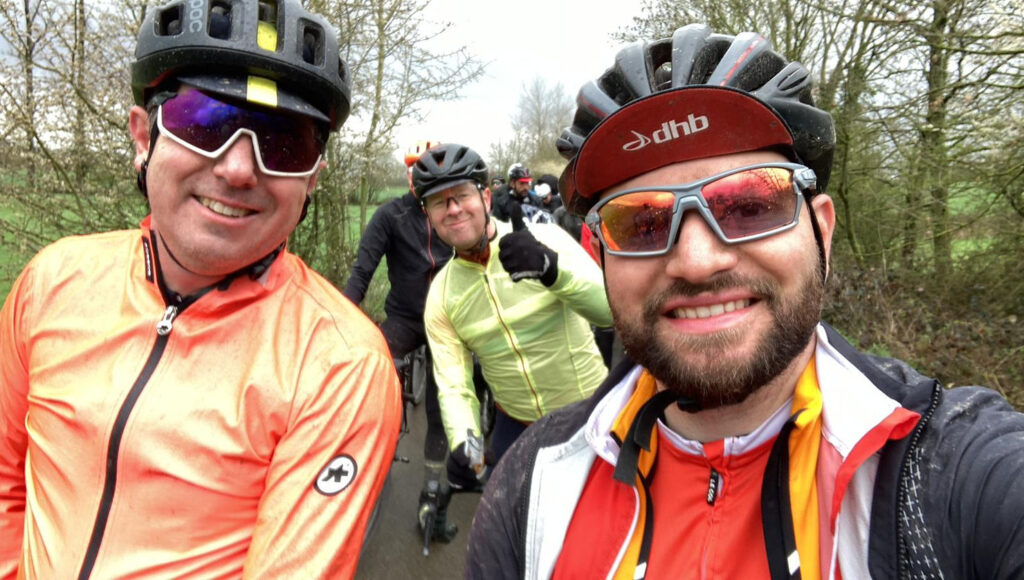
Koppenberg

Other riders walking made the Koppenberg unrideable. After descending the Koppenberg, the route was very similar to the pro-race route. What followed was a series of cobbled climbs every 3 – 5km including the Taaienberg and Berg Ten Houte amongst the others. Whilst none of these were individually difficult, the continual steep cobbles after 120km was starting to take its toll and each one was a bit of a grind. There are cameras on a lot of the climbs filming and having seen myself back, I was certainly battling with the bike up each of the climbs.
Final climb of the Tour of Flanders
After the final feed stop at 140km, there were three climbs in succession. At this point the weather was definitely 100% rain. With a strong wind, at some points visibility was not great particularly on the faster roads/ descents. In a very sadistic way, the third last climb takes you up to the village of Kwaremont, as you then descend on the main road, take two right turns then go back up the historic cobbled road to Kwaremont.
Oude Kwaremont
The Oude Kwaremont is the longest climb on the Tour of Flanders route, at 2.2km long, with an average gradient of 6% and not many steep sections – it is on paper quite similar to box hill and I thought I had this. Oh, how wrong I was. The first part of the cobbles was quite steep and as it flattens out, it is a real grind on very lumpy cobbles to the top.
A deceptively difficult climb where you are being bumped all over the place whilst trying to climb up the hill. After this climb, we descended to the last hill, the Paterberg. This climb is only 360m long, but the gradient is never below 10%, with a mx gradient over 15% and after 160km, it is very difficult. You are on a very fast run in and have to do a sharp right onto the cobbled climb.
Weaving through the traffic
A couple of other riders clearly were in the wrong gear as they had to get off straight away. For most of the hill you can see the top as it rears up in front of you. As I kept going and pedalling, riders were stopping and getting off to walk up the rest of the hill. I was able to keep going, staying seated to ensure the rear wheel didn’t slip.
As I was getting nearer the top, more and more people were stopped and walking. I had to shout to make sure they were aware not to cross my path. In the final third, I was getting encouragement from a French rider behind me who was following me up and wanted to make sure I also didn’t stop. One last final push and I made it to the top, got a cheer from the locals and a pat on the back from the rider behind me.
Ride to the finish
From the top of the Paterberg it was a quick descent before 10km of flat road to the finish on the outskirts of Oudenaarde. Near the end we caught up of Jim and finished within a couple of minutes of each other. I am not sure if it was trying to get to the finish as quick as possible or a tailwind, but we got to the finish, which is the same as the pro race in double quick time. After the finish you are guided through the market square and back to the start where we picked up our Tour Flanders medals / souvenir t- shirts and had some well-deserved chips.
The Tour of Flanders was 175km, included 2055m of climbing over 20 climbs, and 5 flat cobble sectors. Our total time was 9 hrs 20, with a moving time of 7hr 45, average speed was just over 22km/hr. After we got back, and had nice warm showers, we headed into Ghent for some beers, wine and dinner.
The day after the Tour of Flanders
In the morning, after a leisurely breakfast, we checked out of the hotel went back to Oudenaarde for the pro-races. Our initial plan was to go the market square and watch the Pro’s ride the Tour of Flanders on the big screen and get to the finish. After driving around the streets of Oudenaarde looking for somewhere to park, we ended up back out in the industrial area, parked and queued up for a bus which we thought took us back into town.
As we were getting on, we realised it was actually going to Kwaremnont. We then thought yes let’s do this! After we got off the bus, we made our way to the fan area, where there was a big screen and outside bar. We were just next to where to the cobbled climb is. The men’s race goes up the Oude Kwaremont 3 times!
Post tour of Flanders

Watching the race on the big screen
The first time they went passed we could not get anywhere near the side of the road. So we were just content to watch the race on the big screen, drinking beers and mixing with the locals. Prior to the second ascent, we moved out onto the road and were able to get a view of the riders as they came flying past! The roar of the crowd was immense, and so loud for Wout.
We then went back for more drinks, watching the big screen before their next ascent. It was quite exciting wating to see who was going to be first to come past, and amazing to see Pogdacar first, given he was not even in the lead group when they got to the foot of the hill. After watching the end of the race on the big screen, we went back to get the bus back to town, though we had a long wait, though we couldn’t really complain given the day we had enjoyed.
Figure 7 -Watching the pros
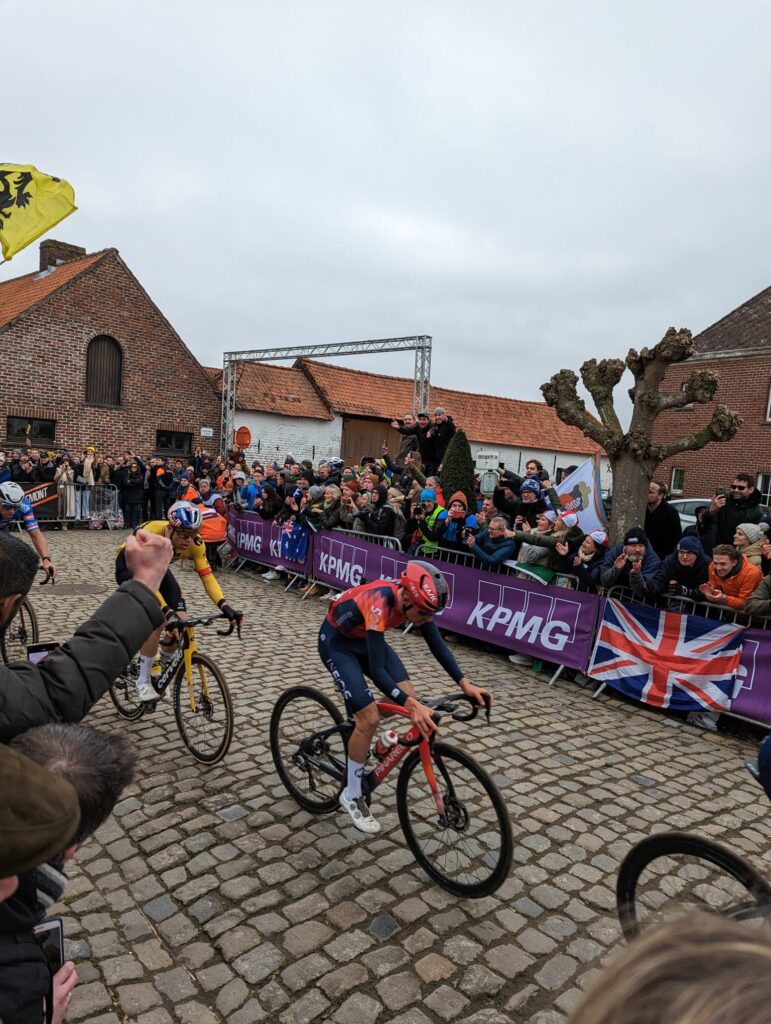
Once back at the cars it was only 1 ½ hours back to Calais and then onto home.
Overall, it was a fantastic weekend, with only the weather during the ride the bad bit. I would thoroughly recommend the Tour of Flanders to anyone. It is very well organised, but also quite relaxed and just really cool to ride the same climbs as the pros.
Would I do it again, well……
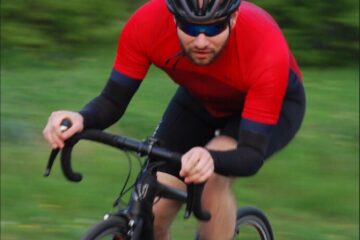
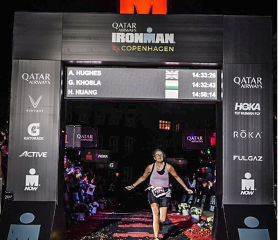
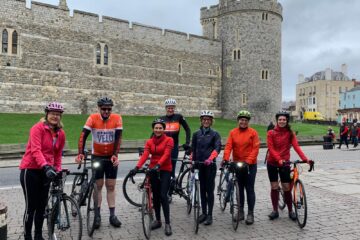
0 Comments